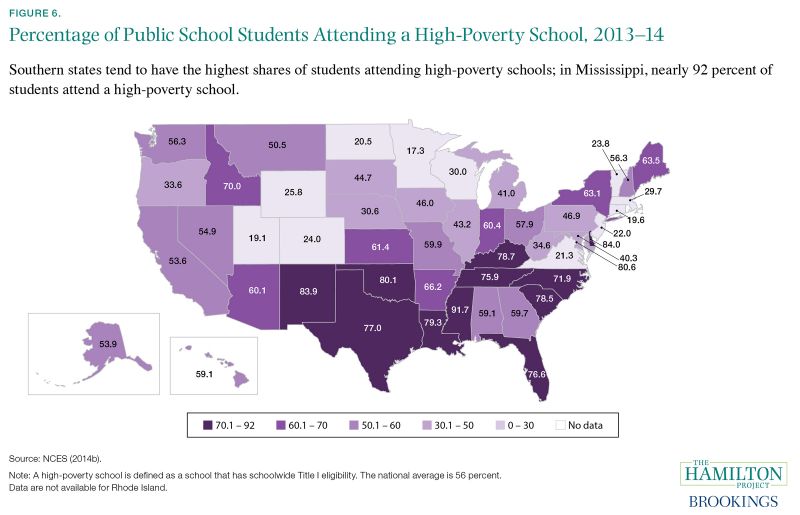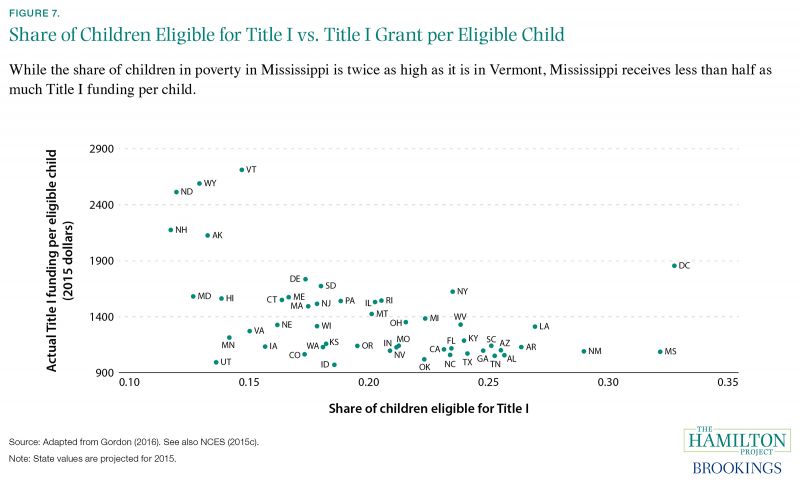Last week, the Hamilton Project released a report on America’s struggling K–12 public education system. The report is full of useful information on the importance of both early education and post-secondary education, but it pays special attention to the country’s high-poverty public schools, which currently educate approximately 56 percent of students nationwide.
As the graph below demonstrates, that percentage is much higher in southern states (in Mississippi, for example, approximately 92 percent of students attend a high-poverty school). The report also highlights a discouraging trend: Many of these schools receive less per-pupil Title I funding than schools in wealthier states.

America’s schools are becoming increasingly more segregated (by race and income), a fact that spells bad news for students. Schools with a high percentage of low-income students struggle to attract and retain qualified teachers. In Charlotte, North Carolina, researchers have linked the re-segregation of schools to higher criminal activity, lower test scores, lower graduation rates, and declines in college attendance rates. High-poverty schools also struggle with resources and funding, which is especially troublesome because low-income students are the most likely to need higher-quality teachers, after-school tutoring, and other supplemental services.
This is in no small part due to America’s education funding system. School districts derive 90 percent of their funding from state and local revenues. Districts in wealthy areas are able to raise substantially higher levels of local revenues, and most states’ education funding formulas fail to direct enough state revenues to poor districts to correct these inequities. But federal funding plays a role as well. Title I of the Elementary and Secondary Education Act of 1965 was created with the explicit goal of providing supplemental federal funds to low-income students and the schools that educate them.
Here’s what the text of the law states:
In recognition of the special educational needs of children of low-income families and the impact that concentration of low-income families have on the ability of local educational agencies to support adequate educational progress, the Congress hereby declares it to be the policy of the United States to provide financial assistance … to local education agencies serving areas with concentrations of children from low-income families to expand and improve their educational programs by various means which contribute particularly to meeting the special educational needs of educationally deprived children.
Unfortunately, Title I has fallen far short of its original mission. The Hamilton Project report concludes that states with higher percentages of low-income students actually receive less per-pupil Title I funding. So why does a federal education funding system that was created to correct education inequities do the exact opposite?
In a policy proposal released alongside the report, Nora Gordon, a Hamilton Project researcher and professor at Georgetown University, provides some context. Title I funding formulas are complicated, she explains, but allocations are based on six criteria: average per-pupil spending, state size, historical funding allocations, the ratio of education spending to per-capita income, and within-state variations in local school spending. Some of those criteria are accompanied by mandatory minimums—there’s a minimum funding level for smaller states, for example, and the historical allocation criteria includes a “hold-harmless” rule that requires a minimum funding level based on previous years’ funding levels.
Here’s the problem: Congress doesn’t fully fund Title I (by a long shot), but the mandatory minimums aren’t waived in the absence of adequate funding. “The result of these formulas is that the amount of Title I funds per poor child varies greatly even across districts and states with similar poverty rates,” Gordon writes. As a result, small states like Vermont and North Dakota receive substantially higher levels of per-pupil funding than places like Louisiana or Mississippi, despite having lower shares of children eligible for such funding.

Gordon’s paper also includes a series of recommendations for both simplifying the Title I funding process and making it more progressive, including eliminating the small state minimum and (gradually) phasing out the hold-harmless minimum. Under Gordon’s proposed reforms, 36 states would gain per-pupil Title I funds (with Mississippi emerging as the biggest winner), while 14 states and Washington, D.C., would lose funds. Most states would see only minimal losses.
While the reforms that Gordon proposes would no doubt provoke political opposition from smaller states, they’re clearly needed if Title I is to remain true to its original mission.




